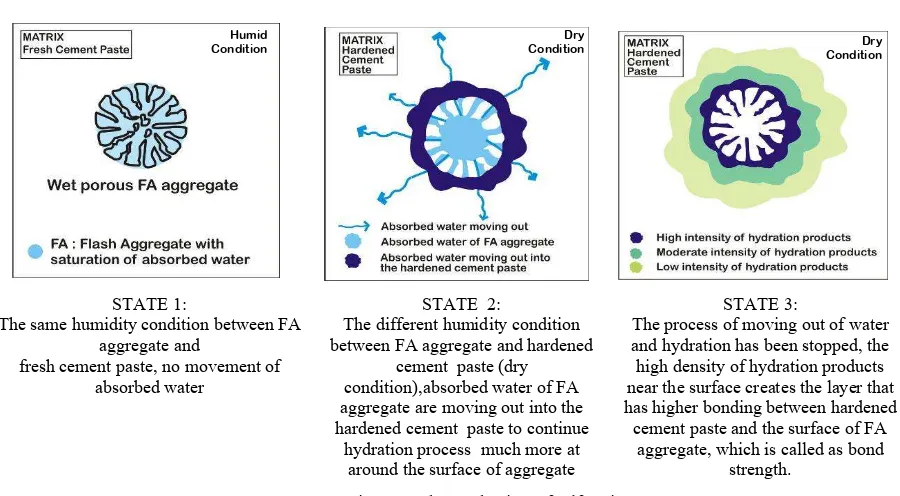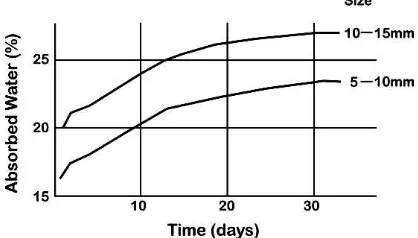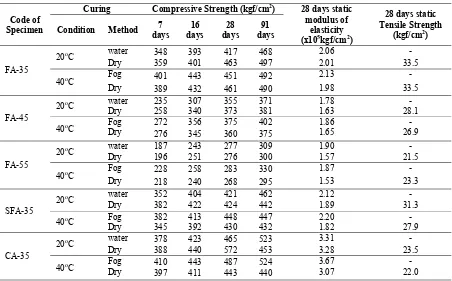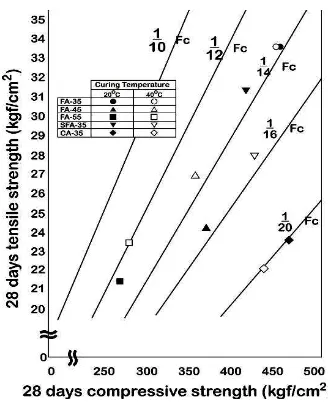INCREASE ON STRENGTHS OF HOT WEATHER CONCRETE BY SELF-CURING
OF WET POROUS AGGREGAT
M
ENINGKATNYAK
EKUATANB
ETONC
UACAP
ANAS DENGANP
ERAWATANS
ENDIRIP
ADAA
GREGATB
ERPORIB
ASAHVictor Sampebulu’
Department of Architecture, Hasanuddin University
Lecturer and Researcher of Laboratory of Building Material, Construction and Structure. Email: vicsam@indosat.net.id
ABSTRACT
Generally, a concrete made in hot weather usually accompanied by a decrease of compressive and tensile strengths. The loss of much combined water in the concrete body is mostly caused by high evaporation of water or moisture during a period of fresh and hardened concrete. An alternative was needed to cope with this problem. Wet porous aggregate which holds much water than wet ordinary aggregate may solve the problem. Porous aggregate of flyash aggregate usually used in a lightweight concrete is generally linked to low strengths of concrete, but when use it in wet (saturation) condition the aggregate could provide favourable strengths of concrete. An absorbed water within the flyash aggregate, different with combined water in mix design to determine W/C ratio, moves out to the cement paste which has already hardened, thereby, continuing the hydration process. This mechanism is called “self curing” and would intensify much products of hydration therefore increas-ing the strengths. Experiment was done in the room temperature ranged from 20°C to 40°C and with constant at a relative humidity. The results, the self curing occurred within the body of concrete using flyash aggregate, as wet porous aggregate, had provided the higher compressive and tensile strengths compared with concrete using silane flyash and crushed stone aggregates. Even in the high air temperature the self curing gave favourable effect on the compressive and tensile strengths as it contributes a better bond strength around the aggregate of flyash.
Keywords: self curing, hot weather concrete, bond strength, fly ash aggregate, wet porous aggregate
ABSTRAK
Umumnya beton yang dibuat di daerah cuaca panas selalu diikuti dengan penurunan kekuatan tekan dan tarik. Kehilangan banyak air campuran di dalam badan beton lebih banyak disebabkan oleh penguapan air atau uap air selama masa beton segar dan keras. Alternatif lain dibutuhkan untuk menyelesaikan masalah tersebut. Agregat berpori jenuh air yang menyerap lebih banyak air dari pada agregat batu pecah diharapkan dapat menyelesaikan masalah kekurangan air di dalam badan beton. Biasanya agregat flyash berpori yang digunakan untuk beton ringan akan selalu dihubungkan dengan rendahnya kekuatan. Kandungan air yang banyak di dalam agregat flyash, bukan bagian faktor air semen, akan menyebar keluar ke dalam pasta semen keras dan kering untuk melanjutkan proses hidrasi, mekanisme ini disebut “selft-curing” dan akan meningkatkan pro-duk hidrasi yang berarti meningkatkan kekuatan. Eksperimen sudah dilakukan di dalam ruangan bertemperatur antara 20o C-40oC dan dengan kelembaban konstan. Hasilnya, self-curing yang terjadi di dalam badan beton yang menggunakan agregat flyash jenuh air telah memberikan kekuatan tekan dan tarik yang lebih tinggi dibandingkan dengan beton agregat batu pecah dan beton ringan agregat flyash jenuh air tetapi dilapisi zat waterproofing (jenis silanol). Meskipun pada temperatur tinggi self-curing memberikan pengaruh memuaskan terhadap kekuatan tekan dan tarik beton agregat flyash karena adanya ke-kuatan rekat lebih baik di sekitar permukaan agregat flyash.
Kata-kata Kunci: perawatan sendiri, beton cuaca panas, kekuatan rekat, agregat abu-terbang, agregat berpori jenuh air
INTRODUCTION
The role of moisture content in hardened concrete gives a specific base for designing concrete, particularly, in hot humid climate at tropical countries. If the total combined water does not escape from the body of concrete, in fresh and hardened condi-tion of concrete, and it continues to create much more hydracondi-tion products, the concrete would have good quality even under a high air temperature. Previous researches resulted that concrete sealed with plastic to prevent the water escapes (Matsufuji et.al, 1988). But this method, in actual operation, would probably be difficult to be applied. An alternative way is needed to cope with this di-fficulty. Wet porous aggregate which holds much water than wet ordinary aggregate may possibly solve the difficulty.
A phenomenon of water absorbed by porous aggregate moving out into the hardened cement paste when concrete is al-ready dry, will be applied to prove the usefulness of the conti-nued presence of moisture in hardened concrete without treat-ment be applied on the concrete surface.
During the process of the movement of water, the whole body will become damp and because of high humidity of air the rate of drying is low. This situation would support a continuation
of wet curing within the body of concrete, and it is called “self curing”. The existence of the self curing is firstly introduced by Prof.Yasunari Matsufuji. In the previous research (Matsufuji et.al., 1986) has suggested that the situation be clear if tempera-ture and humidity are high. Therefore a better quality in terms of strength and drying shrinkage would be produced in hot humid climate (Sampebulu’, 1988).
This experiment will make clear the self curing effect on strengths. Artificial lightweight aggregate of flyash having poro-us structure was poro-used.
MECHANISM OF SELF CURING PROCES
(1) Fresh period 2) self curing process (3) The process ended
STATE 1:
The same humidity condition between FA aggregate and
fresh cement paste, no movement of absorbed water
STATE 2:
The different humidity condition between FA aggregate and hardened
cement paste (dry condition),absorbed water of FA aggregate are moving out into the hardened cement paste to continue
hydration process much more at around the surface of aggregate
STATE 3:
The process of moving out of water and hydration has been stopped, the high density of hydration products near the surface creates the layer that has higher bonding between hardened cement paste and the surface of FA
aggregate, which is called as bond strength.
Figure 1. The mechanism of self curing
The water movement is caused by the humidity gradient between the aggregate that is high and the cement paste that is low. Since the hydrating reaction which inevitably absorbed water while the concrete is in the fresh and hardened states, the free water (com-bined water) will decrease until little is late to saturate the solid surfaces of hydrated cement. This is known as “self-desiccation”. This desiccation will occur rapidly in high temperature. As a con-sequence, the relative humidity attains to the equilibrium condi-tion.
As the paste already filled with water again, the inter-rupted hydration process would resume the continue for relative-ly long time. This would create much more hydration products than in such case that absolutely no moisture or water moves to the paste. Thus, with wet porous of aggregate, the absorbed water allows wet curing within the body of concrete to continue, taking part in hydration. The more proper term for naming this process is “self curing”. The mechanism of the self curing is shown in Figure 1. This term will distinguish this curing form another type of curing process that is almost similar, i.e. autogenous curing described by A.M. Neville (Neville, 1982).
The difference of the two type is in their way of water supply and temperature require to continue the curing. In the self curing, the water comes from the aggregate, and this curing could take place in high and low temperature environment. While the autogenouscuring is operated otherwise.
The autogenous curing is the curing, in adiabatic condition, utilizing the heat generated by the hydration of ce-ment’s pure compounds. A specimen is sealed in a plastic bag after mixing and then placed in a polyurethane container for 46 hours. It wo-uld be expected that the water to function in water curing comes from the free water already escaped as vapour around the
container, and from that still existed within the body of specimen. This, of course, differs with the process found in the self curing.
METHODOLOGY
To prove the presence of self curing and its effect on strengths, several procedures, materials and mix proportions were attempt-ted for use in this case.
Materials and Mix Proportions
All mixes used the same materials of cement and fine ag-gregate. Ordinary Portland cement was used as cement and river sand as fine aggregate. Two types of coarse aggregate were used, i.e. artificial lightweight of Fly Ash (FA) and crushed stone. In this experiment, FA aggregate was used because it, unlike a natural porous aggregate, has more homogeneous pores within the interior to the surface and among each of the pieces.
Two types of FA aggregate were used in this experiment. First type was FA aggregate as wet porous aggregate which holds much water. Second type was of the same FA aggregate but im-mersed into a silanol agent before mixing was done. As the silanol agent is the type of waterproofing material, initially ab-sorbed water of the silanol-immersed aggregate, in terms of self curing, would not move or no water movement between the ag-gregate and the cement paste. This agag-gregate type is called Silane Fly Ash (SFA) aggregate.
Physical characteristics of all types of aggregates used and mix proportions are presented in Table 1 and 2. In the Table 1, the FA aggregate has a high absorptive capacity compared with other types.
Table 1. Physical characteristic of aggregate used
Aggregate
Condition Condition Dry Dry
Generally, as shown in Figure 2, this FA aggregate has ab-sorbed water about 50% of its total absorption at saturation only in 30 seconds, 70% in one day, and attained to equilibrium in one month. But in this experiment, FA aggregate at time of mixing did not quite attain to the saturation point.
Mix proportions of concrete and mortar are shown in Table 2. Based on the purpose of this experiment, proportions of water and coarse aggregate were made constant so as to allow the effect of self curing in relation with various water-cement ratios. Che-mical admixtures were also added into the mixes, air-entrained agent of vinsol type and water-reducing of high flood type.
Figure 2. Increase of water absorbed by Fly Ash aggregate with increase in time (Tomosawa, AIJ)
Table 2. Mix proportions
W/C (%) Slump
The methods used are drawn in Table 3 for strength test. Japanese Standard Specification of SA 1108 method was
applied for compressive strength test and purely-pulled method for tensile strength test.
Table 3. Outline of experiment for strength test
Code of Specimen Temperature of
Material (oC)
Note: (*) FA- Flyash aggregate, SFA-Silane Flyash Aggregate CA- Crushed Stone Aggregate, RH-Relative Humidity
Table 4. Result of fresh concrete
RESULT AND DISCUSSION
Properties of fresh concrete are shown in Table 5. The slump test result was about 18 cm for concrete using FA and a-bout 21 cm for concrete using crushed stone aggregate. Except, for W/C 35%, the same of slump of about 21 cm for FA-35 and CA-35.
In general, FA aggregate concrete is characterized by much air content and lighter unit weight, Table 4.
Since FA aggregate as porous aggregate is usually not satu-rated completely with water thus with a great deal of air still re-maining in the aggregate, the use of an ordinary pressure method for measuring the air content of fresh FA aggregate concrete is rather difficult.
Strengths
The characteristics of strengths to be discussed consist of compressive and tensile strengths, and static modulus of elas-ticity.
Compressive strength
Varying in the amount of absorbed water of aggregates with a constant water-cement ratio (35%), FA concrete attained to higher compressive strength than SFA and CA concrete. The effect of self curing had appeared at 28 days strength in com-parison of the result of FA concrete with that of SFA concrete. In dry curing at both 20oC and 40oC curing conditions, the strength of FA concrete was 30-40 kgf/cm2 higher than that of SFA concrete. The strength of FA concrete continuously increased in a range of age from 28 to 91 days but the opposite results found for SFA and CA concrete, see Figure 3.
Since a W/C ratio is constant, it is expected that only one factor causes the increase, namely, the self curing in which the absorbed water of FA aggregate moves into the hardened cement paste and then the hydration process once interrupted would resu-me to go on. This is the greatest possibility that would take place and could be believed because the W/C ratio is constant. The dry, RH‐70%
water
Dry,RH‐70%
most clear evidence of self curing effect is that the laterage strength of FA concrete is stronger than crushed stone aggregate concrete. This is contrary to the visual case in which an ordinary concrete is stronger than all types of a lightweight concrete. This usual case appeared in water and fog curing at both 20oC and 40oC in which the CA concrete had 520 kgf/cm2 at 91 days, Ta-ble 5, that was the highest strength in this experiment. This value is lower by about 70-80 kgf/cm2 for that in drying curing.
Figure 3. Effect of curing temperature on the compressive strength of flyash, silane flyash and crushed stone aggregate.
Dry curing, W/C = 35%.
Table 6 shows the percentage difference in compressive strength from the dry curing to those from the water and the fog curing. Values of crushed stone aggregate concrete in 40oC cu-ring decreased with time increased. At least two factors, shape and absorbed water of aggregate, are responsible for that decrea-sing. Pockets (voids) are formed easily underneath an angular shape of crushed aggregate, unlike a globular shape of FA aggre-gate, during the fresh state period when a process of bleeding or sedimentation is taking place (Sampebulu’, 2008).
The ratio of W/C 35% and less than 1% of absorbed water of the aggregate are small values. While the bleeding is going on, the water would be trapped within the formed pockets between aggregate and matrix. After the bleeding finishes and the con-crete has hardened, the pockets will dry when curing goes on in dry condition. This will leave the pockets dried. As a cones-quence, the pockets will become a cause of crack as they consist of just air and soft parts. Moreover, the edges of angular ag-gregate would produce a concentration stress when concrete is subjected to load forces and this then increases the possibility of cracks occurring easily around the pockets.
The effect W/C ratio on strength is clearly seen in Table 6. For both 20oC and 40oC the smaller the W/C ratio the higher the percentage difference of comprehensive strength was found. The density of concrete thus seems to have relation with this. The density will become heavier as the absorbed water moves from FA aggregate. The water would continue to create more hydra-tion products around the aggregate pieces. Therefore, this would improve bond strength between the aggregate and the cement paste.
Table 5. Results of hardened concrete, strength test
Code of Specimen
Curing Compressive Strength (kgf/cm2) 28 days static modulus of
elasticity (x105kgf/cm2)
28 days static Tensile Strength
(kgf/cm2) Condition Method 7
days 16 days
28 days
91 days
FA-35
20oC water 348 393 417 468 2.06 -
Dry 359 401 463 497 2.01 33.5
40oC Fog 401 443 451 492 2.13 -
Dry 389 432 461 490 1.98 33.5
FA-45
20oC water 235 307 355 371 1.78 -
Dry 258 340 373 381 1.63 28.1
40oC Fog 272 Dry 356 375 402 1.86 -
276 345 360 375 1.65 26.9
FA-55
20oC water 187 243 277 309 1.90 -
Dry 196 251 276 300 1.57 21.5
40oC Fog 228 258 283 330 1.87 -
Dry 218 240 268 295 1.53 23.3
SFA-35
20oC water 352 404 421 462 2.12 -
Dry 382 422 424 442 1.89 31.3
40oC Fog 382 413 448 447 2.20 -
Dry 345 392 430 432 1.82 27.9
CA-35
20oC water 378 423 465 523 3.31 -
Dry 388 440 572 453 3.28 23.5
40oC Fog 410 443 487 524 3.67 -
Dry 397 411 443 440 3.07 22.0
The development of strength in dry curing was greater for the concrete made with FA aggregate. The different strength ratios of dry curing to the water and fog curing are shown from Figure 4 to 5.
Even at 40oC curing temperature, the strength of FA con-crete was greater than that of CA concon-crete (Figure 4). Various
Table 6. Percentage difference in compressive strength of dry curing to the strength of water and fog curing
Figure 4. Development of compressive strength in 20oC and 40oC of dry curing compared with the strength in both temperatures of water and fog curing. W/C=35%. Aggregate used: flyash, silane flyash and crushed
stone.
Figure 5. Development of compressive strength in 20oC and 40oC of dry curing compared with the strength in both temperatures of water and fog
curing W/C=35%, 45%, 55%. Aggregate used: flyash
Tensile Strength
Tensile strengths of each type of concrete are shown in Table 5, to prove the self curing effects no testing was done for specimens by water and fog curing.
Various degrees of tensile strength were found for the FA concrete specimens classified in 4 types of W/C ratio. The streng-ths for W/C 35% was the highest among them. Apparently low
total water gives better tensile strengths. Based on purely visual observation of the broken surface of specimens already tested, apparent pieces of FA aggregate were cut in two parts. This in-dicates that the bond strength around the aggregate worked fa-vourably. The remaining bond layers were seen around the bro-ken FA aggregates. The remarkable indication was that all the apparent aggregates had broken in FA concrete of W/C 35%.
It is obvious that the water once absorbed in FA aggregate has already moved out into the hardened cement paste to main-tain the hydration process. And the progress of the process is recognized much more in the cement paste around the FA aggregate (Figure 1). The result of the process, therefore, would improve the bond strength. This has been clearly proven by the case of W/C 35% in which the tensile strength of FA concrete was the highest compared with the concrete of other W/C ratios.
No effect of self curing can be seen in SFA concrete for which the tensile strength by curing at 40oC was lower than that at 20oC due to the self desiccation occurring more rapidly under high temperature (see section 2). Because no surplus water sup-plies the self desiccated water, use of SFA aggregate would wea-ken a tensile strength.
A comparison between compressive and tensile strength at the age of 28 days is shown in Figure 6.
Tensile strength of FA concrete ranges from 1/12 to 1/16 of its compressive strength. No different value was found between 20oC and 40oC curing conditions for FA-35 but the value varied for FA-45 and FA-55 in which the value was higher for 40oC.
A multiple reaction of hydration will take place when ambient temperature is high (Idron, 1968). Because of self curi-ng, this chemical reaction to take place between the aggregate and cement paste increases their bond strength.
On the contrary, the value was lower for 40oC curing condition for SFA and CA concrete. Because such aggregate has neither exit nor enough water, the self curing does not work in the both cases. In addition, 40oC of air temperature will cause much rapid water evaporating from the concrete. This condition, high temperature and lack of water in the body, dries the con-cretes out and as a result their bond strength does not built up.
Figure 6. Relation Between Compressive and Tensile Strength at the age of 28 days
pie-ces of the aggregate. If tensile force is given to such a zone under this circumstance, cracks develop initially in the zone before spreading to other zones in the concrete body.
There are two indications about the magnitude of bond stren-gth between the aggregate and cement paste on the specimen that is broken off by a pulling force. Firstly, if the apparent pieces of the aggregate are broken with mortar matrix around them, this indicates that the bond is strength enough to its ultimate power to hold the aggregate. But, secondly, if the aggregates are not bro-ken this means the bond is weak. By examining the brobro-ken sur-face of the specimens, the first indication appears on all the FA aggregates and the second on all the CA (crushed stone) gates and a half of SFA aggregates. The last case of SFA aggre-gates provides another theory that a globular shape and open po-res appeared on aggregate surface are also the factors enhancing the bond strength.
Modulus of Elasticity
Modulus of elasticity to be determined by applying a static method was obtained from 1/3 Tmax of 28 days strength. In all the concretes shown in Table 5, the elasticities resulted from dry curing were smaller than those from water and fog curing. There is a tendency in FA concrete that the elasticity will decrease with increase in a ratio of water cement.
Comparing between FA and SFA concrete under dry curing condition the elasticity of FA concrete was slightly high. Since the W/C ratio is constant, only the factor that may explain the dif-ference is possible improvement of bond strength between aggre-gate and matrix through the self curing.
CONCLUSION
The existence of self curing in concrete using flyash aggre-gate as wet porous aggreaggre-gate, has provided favourable effects on properties of concrete. Several conclusions are drawn as the sig-nificant effects of the self curing.
In moderate and high ambient temperature, flyash aggregate concrete provides higher compressive and tensile strengths com-pared with silane flyash and crushed stone aggregate concrete. Particularly for tensile strength, the higher temperature gives a favourable effect as it contributes a better bond strength around the flyash aggregate.
There is a tendency that high temperature accompanied by high relative humidity would give a favourable effect on pro-perties of concrete if wet porous aggregate is used. Thus, it should be widely applied in making concrete in hot humid envi-ronment.
REFERENCES
Idron, G.M. (1968). “Hydration of Portland Cement Paste at High Temperature Under Atmospheric Pressure.” Proceedings of The 5th International Symposium on The Chemistry of Ceme-nt, Vol III, Tokyo, pp.411-428.
Matsufuji, Y, Ohkubo, T., Harada S and Sampebulu’, V. (1988). “A Study on strength of Concrete Mixed and Cast in High Temperature Ambience.” Proceeding of The Japan Concrete Institute, Vol.10, No.2, 1988, pp. 277-280.
Matsufuji, Y, Shigetoku K and Sampebulu’, V. (1986) “Pro-perties of Open Pores Aggregate Concrete in Hot Weather.” The Cement Association of Japan, 1986, pp.124-127
Neville, A.M. (1982). Properties of Concrete, Pitman Books Li-mited, Third Edition, 1982, p572.
Sampebulu’, V. (1988). “A Basic Study on The Properties of Hot Weather Concrete.” Dissertation of Doctor’s Degree, pp.131-145.
Sampebulu’, V. (2001). “Pengaruh Cuaca Panas terhadap Kua-litas Beton.” National Seminar of Indonesia, Makassar, 2001, The 5th Paper.



